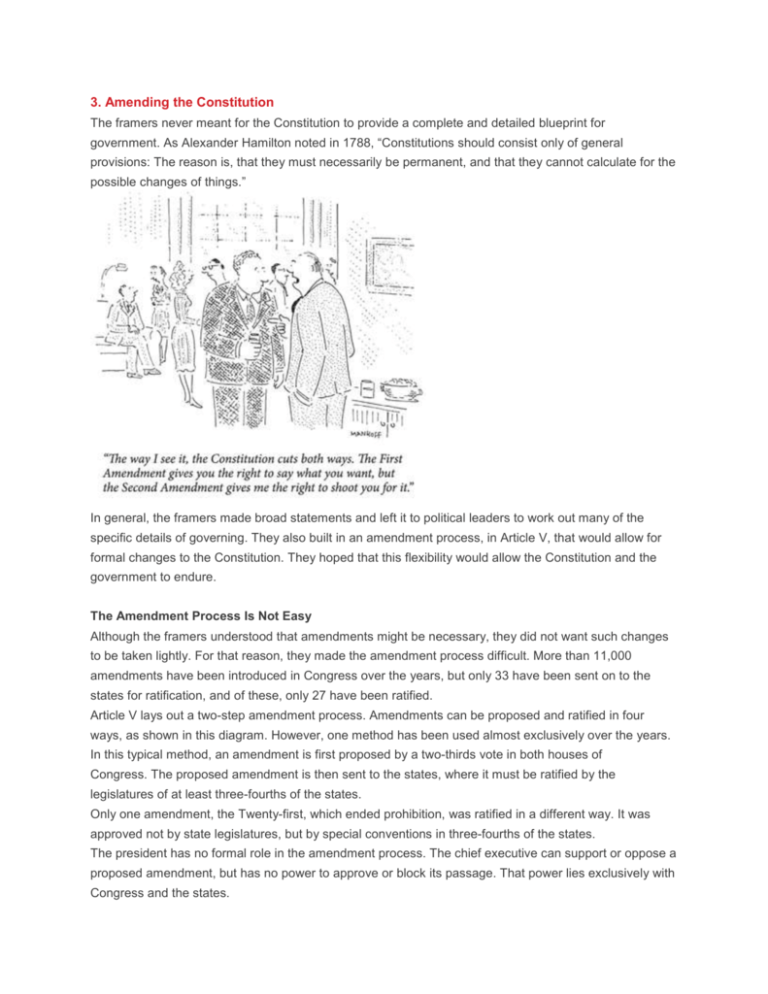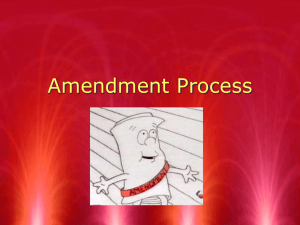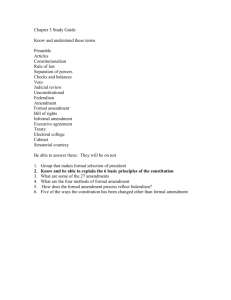
3. Amending the Constitution
The framers never meant for the Constitution to provide a complete and detailed blueprint for
government. As Alexander Hamilton noted in 1788, “Constitutions should consist only of general
provisions: The reason is, that they must necessarily be permanent, and that they cannot calculate for the
possible changes of things.”
In general, the framers made broad statements and left it to political leaders to work out many of the
specific details of governing. They also built in an amendment process, in Article V, that would allow for
formal changes to the Constitution. They hoped that this flexibility would allow the Constitution and the
government to endure.
The Amendment Process Is Not Easy
Although the framers understood that amendments might be necessary, they did not want such changes
to be taken lightly. For that reason, they made the amendment process difficult. More than 11,000
amendments have been introduced in Congress over the years, but only 33 have been sent on to the
states for ratification, and of these, only 27 have been ratified.
Article V lays out a two-step amendment process. Amendments can be proposed and ratified in four
ways, as shown in this diagram. However, one method has been used almost exclusively over the years.
In this typical method, an amendment is first proposed by a two-thirds vote in both houses of
Congress. The proposed amendment is then sent to the states, where it must be ratified by the
legislatures of at least three-fourths of the states.
Only one amendment, the Twenty-first, which ended prohibition, was ratified in a different way. It was
approved not by state legislatures, but by special conventions in three-fourths of the states.
The president has no formal role in the amendment process. The chief executive can support or oppose a
proposed amendment, but has no power to approve or block its passage. That power lies exclusively with
Congress and the states.
Only one provision of the Constitution—the equal representation of states in the Senate—is not open to
amendment. This point is made explicit in Article V: “no State, without its Consent, shall be deprived of its
equal Suffrage in the Senate.” This prohibition was meant to ensure that all states—even the smallest
and least populated—would always have two seats in the Senate. This was a key compromise worked
out during the writing of the Constitution.
Some critics contend that the equal-representation provision is undemocratic. They point out that today
over half the U.S. population lives in just nine states:California, Texas, New York, Florida, Illinois,
Pennsylvania, Ohio, Michigan, and Georgia. Yet just 18 out of 100 senators represent this half of the
population.
The First Ten Amendments: The Bill of Rights
The first ten amendments to the Constitution—also known as the Bill of Rights—were proposed by
Congress in 1789 and ratified by the states in 1791. The rights listed in the Bill of Rights outline the
freedoms guaranteed to the people and the states.
First Amendment: Basic freedoms. Guarantees five basic freedoms: religion, speech, press, assembly,
and petition.
Second Amendment: Right to bear arms. Protects the right to bear arms and form state militias. The
national and state governments, however, claim the right to regulate firearms.
Third Amendment: Quartering of soldiers. Bans quartering of troops in private homes during
peacetime. This was a key concern in the 1700s but has little relevance today.
Fourth Amendment: Search and seizure. Prevents unreasonable search and seizure. Police and other
authorities have no right to search or seize property or people without just cause.
Fifth Amendment: Rights of the accused. Outlines the right to due process of law and other legal
protections. This amendment covers various rights of people accused of crimes. It also covers eminent
domain, which prevents the government from taking over private property without just or fair
compensation.
Sixth Amendment: Right to a fair trial. Guarantees the right to public and speedy trial by a jury in
criminal cases. The accused also has other rights such as to call witnesses and to be represented by an
attorney.
Seventh Amendment: Civil trials. Guarantees the right to jury trial in civil cases. A civil case, such as a
lawsuit, is one that does not involve criminal conduct.
Eighth Amendment: Bail and punishment. Bans excessive bail and punishment. The courts may not
impose unreasonable bail, fines, or cruel and unusual punishment.
Ninth Amendment: Rights retained by the people. Guarantees other rights not listed in the
Constitution or Bill of Rights.
Tenth Amendment: States’ rights. Reserves powers for the states and the people that are not
specifically given to the national government.
Two Early Amendments Strengthened the New Federal Government
The remaining amendments came about because of a widely recognized problem, or as the result of a
reform movement, or both. The first of these, the Eleventh Amendment, adopted in 1795, protected states
from lawsuits by citizens of other states or foreign countries. It was adopted after Georgia lost a Supreme
Court case involving a suit brought by a South Carolina resident.
The Twelfth Amendment, ratified in 1804, changed voting procedures in the Electoral College to separate
the vote for president and vice president. This became necessary after the 1800 election resulted in an
Electoral College tie.
Three Civil War–Era Amendments Extended Rights to African Americans
The Thirteenth Amendment made President Lincoln’s emancipation of slaves the law of the land.The
Fourteenth Amendment overturned the Supreme Court’s Dred Scott decision—which had denied
citizenship to African Americans—by making all people born in the United States citizens with equal rights
and protections. The Fifteenth Amendment was passed to protect the voting rights of freedmen during
Reconstruction.
Four Progressive-Era Amendments Dealt with Social and Political Reforms
The Progressive period of the early 1900s saw the ratification of four amendments, all designed to
promote social and political reform. The Sixteenth Amendment allowed Congress to establish an income
tax. Today the income tax is the main source of revenue for the federal government.
The Seventeenth Amendment provided for the direct election of senators. Previously, senators were
elected by state legislatures. The Nineteenth Amendment extended voting rights to women.
The Eighteenth Amendment instituted prohibition, banning the sale of alcohol. The Twenty-first
Amendment later repealed prohibition.
Four Twentieth-Century Amendments Addressed Governance
The Twentieth Amendment changed the start date of presidential and congressional terms. Known as the
“lame duck” amendment, it shortened the period in which officeholders who had not been reelected
remained in office.
The Twenty-second Amendment limited presidents to two terms. This amendment was prompted by the
election of Franklin D. Roosevelt to four terms. The Twenty-fifth Amendment provided for succession to
the presidency in case of a president’s death or disability and the filling of a vacancy in the office of vice
president.
The Twenty-seventh Amendment—the last to be ratified, in 1992—was first proposed 203 years earlier,
along with the Bill of Rights. It states that any pay raise Congress votes for itself cannot go into effect until
after the next congressional election.
Three Civil Rights–Era Amendments Extended Voting Rights
Between 1961 and 1971, three amendments expanded suffrage for different groups. The Twenty-third
Amendment allowed residents of the District of Columbia to vote in presidential elections. As a result,
district voters now elect three members of the Electoral College.
The Twenty-fourth Amendment banned poll taxes, which had been used to keep African Americans from
voting in some states.
The Twenty-sixth Amendment lowered the voting age from 21 to 18. Ratified during the Vietnam War, it
was prompted by arguments that anyone who is old enough to go to war—that is, an 18-year-old—is old
enough to vote.
Of all the amendments proposed by Congress but never ratified by the states, perhaps the most famous
is the equal rights amendment. The ERA, first introduced in 1923, was intended to guarantee equal rights
for women. It was proposed by Congress again in 1972, but did not win ratification in the necessary threefourths of the states.







